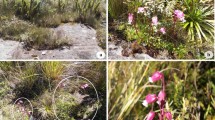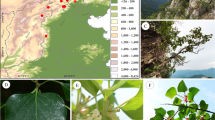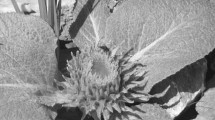Abstract
Naufraga balearica is an endemic umbelliferous plant of Mallorca (Balearic Islands, Spain), considered Critically Endangered according IUCN categories. We present a study of its reproductive biology to look for the causes of its threatened status. It was carried out in natural populations at Cap de Catalunya and Coves Blanques and in ex-situ cultivated plants on the campus of the Universitat de les Illes Balears. We examined (1) the flowering and fruiting phenology, reproductive potential and reproductive success; (2) the pollen/ovule (P/O) ratio and mating system; (3) the identities and numbers of pollinators; (4) the germination potential and the effect of temperature on the germination process; and (5) the seedling performance of this species. The results indicated that under natural conditions, an average individual produced approximately 100 seeds and cross-pollination was the most effective mating system. Pollination was myrmecophilous, and the germination potential was high (76–97%), but seedling survival after the first summer was low (7–54%). We conclude that the major threats to this species are fundamentally extrinsic in character and are related to changing climatic conditions, soil erosion and alteration, and umbel predation. Given that cross-pollination yields greater reproductive success and that pollination is myrmecophilous, lower population densities would lead to lower reproductive success for the species. Therefore, conservation efforts should focus primarily on habitat conservation and on ex-situ conservation through the establishment of an ex-situ population and the maintenance of a seed bank.





Similar content being viewed by others
References
Arnold G (1922) A monograph of the Formicidae of South Africa. Part 5. (Myrmicinae). Ann S Afr Mus 14:579–674
Ayerbe JM, Ceresuela JL (1982) Germinación de especies endémicas españolas. An Inst Nac Invest Agrar Ser For 6:17–41
Bacchetta G, Bueno A, Fenu G, Jiménez-Alfaro B, Mattana E, Piotto B., Virevaire M (eds) (2008) Conservación ex situ de plantas silvestres, 1st edn. Principado de Asturias/La Caixa
Bas JM, Gómez C (2003) Formigues dispersadores de llavors de Rhamnus alaternus (L.). Ses Entom ICHN-SCL 12:75–84
Beattie AJ, Hughes L (2002) Ant–plant interactions. In: Herrera CM, Pellmyr O (eds) Plant–animal interactions. An evolutionary approach. Blackwell, Australia, pp 211–235
Beattie AJ, Turnbull C, Knox RB, Williams EG (1984) Ant inhibition of pollen function: a possible reason why ant pollination is rare. Am J Bot 71(3):421–426
Bell CR (1971) Breeding systems and floral biology of the Umbelliferae, or evidence for specialization in unspecialized flowers. In: Heywood VH (ed) The biology and chemistry of the Umbelliferae. Academic Press, London, pp 93–107
Bernard F (1968) Les fourmis (Hymenoptera, Formicidae) d’Europe occidentale et septentrionale. Masson, Paris
Bibiloni G, Soler J (2002) Notes florístiques de les Illes Balears (XIV). Aportació al coneixement de la flora de Mallorca. Boll Soc Hist Nat Balears 45:51–57
Blancafort X, Gómez C (2005) Consequences of the Argentine ant, Linepithema humile (Mayr), invasion on pollination of Euphorbia characias (L.) (Euphorbiaceae). Acta Oecologica 28:49–55. doi:10.1016/j.actao.2005.02.004
Bosch J, Retana J, Cerdá X (1997) Flowering phenology, floral traits and pollinator compoistion in a herbaceous Mediterranean plant community. Oecologia 109(4):583–591. doi:10.1007/s004420050120
Briggs D, Walters SM (1997) Plant variation and evolution, 3rd edn. Cambridge University Press, Cambridge
Cardona MA (1977) Contribució a l’estudi citotaxonòmic de la flora de les Balears. III Butll Inst Cat Hist Nat Secc Bot 41:83–94
Castro M, Rosselló JA (2005) Chromosome numbers in plant taxa endemic to the Balearic Islands. Bot J Linn Soc 148:219–228. doi:10.1111/j.1095-8339.2005.00397.x
Constance L, Cannon J (1967) Naufraga—a new genus of Umbelliferae from Majorca. In: Tutin TG, Heywood VH et al (eds) Flora Europaea Notulae Systematicae ad Floram Eropaeam spectantes 6. Feddes Reppert Spec Nov Regni Veg 74 (1–2):1–4
Cruden RW (1977) Pollen–ovule ratios: a conservation indicator of breeding systems in flowering plants. Evolution 31:32–46
Cruden RW (2000) Pollen grains: why so many? Plant Syst Evol 222:143–165. doi:10.1007/BF00984100
Cruden RW, Hermann-Parker SM (1977) Temporal dioecism: an alternative to dioecism? Evolution 31:863–866
Dafni A, Kevan PG, Husband BC (2005) Practical pollination biology, 1st edn. Enviroquest Ltd, Canada
Davila YC, Wardle GM (2002) Reproductive ecology of the Australian herb Trachymene incisa subsp. incisa (Apiaceae). Aust J Bot 50:619–626
Davila YC, Wardle GM (2008) Variation in native pollinators in the absence of honeybees: implications for reproductive success of an Australian generalist-pollinated herb Trachymene incisa (Apiaceae). Bot J Linn Soc 156(3):479–490
De Vega C, Arista M, Ortiz PL, Herrera CM, Talavera S (2009) The ant-pollination system of Cytinus hypocistis (Cytinaceae), a Mediterranean root holoparasite. Ann Bot 103(7):1065–1075. doi:10.1093/aob/mcp049
Downie SR, Katz-Downie D, Spalik K (2000) A phylogeny of Apiaceae tribe Scandiceae: evidence from nuclear ribosomal DNA internal transcribed spacer sequences. Am J Bot 87(1):76–95
Duvigneaud J (1970) Ecologie de Naufraga balearica Constance & Cannon (Umbelliferae). Bull Soc Roy Bot Belgique 103:31–38
Evans MEK, Menges ES, Gordon DR (2003) Reproductive biology of three sympatric endangered plants endemic to Florida scrub. Biol Conserv 111:235–246. doi:10.1016/S0006-3207(02)00293-8
Fridlender A (2001) Naufraga balearica Constance & Cannon (Apiaceae); description, écologie, répartition et projets de conservations en Corse. Soc Bot France J bot 13:7–24
Fridlender A, Boisselier-Dubayle MC (2000) Comparision de la diversité génétique (RAPD) de collections ex situ et de populations naturelles de Naufraga balearica Constance & Cannon. Compt Rendus Acad Sci III Sci Vie 323(4):399–406
Gamisans J, Moret J, Fridlender A, Deschartes R, Dutartre G (1996) Le Naufraga balearica est-il éteint en Corse? Etude du site originel, recherche de station comparables, possibilités de réintroduction. Candollea 51:552–557
Gaudeul M, Till-Bottraud I (2003) Low selfing in a mass-flowering, endangered perennial, Eryngium alpinum L. (Apiaceae). Am J Bot 90(5):716–723. doi:10.3732/ajb.90.5.716
Gaudeul M, Till-Bottraud I (2004) Reproductive ecology of the endangered alpine species Eryngium alpinum L. (Apiaceae): phenology, gene dispersal and reproductive success. Ann Bot 93:711–721. doi:10.1093/aob/mch098
Gilpin ME, Soulé ME (1986) Minimum viable populations: processes of species extinction. In: Soulé ME (ed) Conservation biology: the science of scarcity and diversity. Sinauer, Massachusetts, pp 19–34
Gómez JM (2000) Effectiveness of ants as pollinators of Lobularia maritima: effects on main sequential fitness components of the host plant. Oecologia 122:90–97. doi:10.1007/PL00008840
Gómez JM (2002) Self-pollination in Euphrasia willkommii Freyn (Scrophulariaceae), an endemic species from the alpine of the Sierra Nevada (Spain). Plant Syst Evol 232(1–2):63–71. doi:10.1007/s006060200027
Gómez JM, Zamora R (1992) Pollination by ants: consequences of the quantitative effects on a mutualistic system. Oecologia 91:410–418. doi:10.1007/BF00317631
Gómez JM, Zamora R (1999) Generalization vs. specialization in the pollination system of Hormantophylla spinosa (Cruciferae). Ecology 80:796–805
Gómez JM, Zamora R, Hódar JA, García D (1996) Experimental study of pollination by ants in Mediterranean high mountain and arid habitats. Oecologia 105(2):236–242. doi:10.1007/BF00328552
Hickman JC (1974) Pollination by ants: a low-energetic system. Science 184:1290–1292
Koul P, Sharma N, Koul AK (1993) Pollination biology of Apiaceae. Curr Sci 65(3):219–222
Langenberger MW, Davis AR (2002) Temporal changes in floral nectar production, reabsorption, and composition associated with dichogamy in annual caraway (Carum carvi; Apiaceae). Am J Bot 89(10):1588–1598. doi:10.3732/ajb.89.10.1588
Lindsey AH (1982) Floral phenology patterns and breeding systems in Thaspium and Zizia (Apiaceae). Syst Bot 7:1–12. doi:10.2307/2418648
Lindsey AH (1984) Reproductive biology of Apiaceae. I. Visitors to Thaspium and Zizia and their importance to pollination. Am J Bot 71(3):375–387
Lindsey AH, Bell CR (1985) Reproductive biology of Apiaceae. II. Cryptic specialization and floral evolution in Thaspium and Zizia. Am J Bot 72(2):213–247
Llorens L, Gil L, Tébar FJ (2007) La vegetació de l’illa de Mallorca. Bases per a la interpretació i gestió d’hàbitats. Associació Jardí Botànic de Palma, Palma
Marcinko SE, Randall JL (2008) Protandry, mating systems, and sex expression in the federally endangered Ptilimnium nodosum (apiaceae). J Torrey Bot Soc 135(2):178–188. doi:10.3159/07-RA-008.1
Martínez MD, Arnaldos MI, Romera E, García D (2002) Los Formicidae (Hymenoptera) de una comunidad sarcosaprófaga en un ecosistema mediterráneo. An biol 24:33–44
Michalski SG, Durka W (2009) Pollination mode and life form strongly affect the relation between mating system and pollen to ovule ratios. New Phytol 183:470–479. doi:10.1111/j.1469-8137.2009.02861.x
Molano-Flores B (2001) Reproductive biology of Eryngium yuccifolium (Apiaceae), a prairie species. J Torrey Bot Soc 128:1–6. doi:10.2307/3088654
Moragues E (2005) Naufraga balearica (Apiaceae) especie endémica y vulnerable de las Islas Baleares. Biología reproductiva y efecto de la herbivoría. Master thesis, Universitat de les Illes Balears, Palma
Moreno JC (coord.) (2008) Lista Roja 2008 de la flora vascular española. Dirección General de Medio Natural y Política Forestal (Ministerio de Medio Ambiente, y Medio Rural y Marino, y Sociedad Española de Biología de la Conservación de las Plantas), Madrid
Neal PR, Anderson GJ (2004) Does the ‘old bag’ make a good ‘wind bag? : Comparison of four fabrics commonly used as exclusion bags in studies of pollination and reproductive biology. Ann Bot 93:603–607. doi:10.1093/aob/mch068
Nicolas AN, Plunkett GM (2009) The demise of subfamily Hydrocotyloidae (Apiaceae) and the re-alignment of its genera across the entire order Apiales. Mol Phylogenet Evol 53:134–151. doi:10.1016/j.ympev.2009.06.010
Pérez de Paz J (2002) La biologia reproductiva. Importancia y tipos de estudios. In: Banyares A (ed) Biología de la conservación de plantas amenazadas. Organismo Autónomo de Parques Nacionales, Madrid, pp 132–173
Pérez-García F, Pita JM, González-Benito ME, Iriondo JM (1995) Effects of light temperature and seed priming on germination of celery seeds (Apium graveolens L.). Seed Sci Technol 23:377–383
Quinn GP, Keough M (2002) Experimental design and data analysis for biologists. Cambridge, New York
Richards AJ (1997) Plant breeding systems. Chapman & Hall, London
Rovira AM, Bosch M, Molero J, Blanché C (2004) Pollination ecology and breeding system of the very narrow coastal endemic Seseli farrenyi (Apiaceae). Effects of population fragmentation. Nord J Bot 22(6):727–740
Seifert B (1992) A taxonomic revision of the palearctic members of the and subgenus Lasius s. str. (Hymenoptera: Formicidae). Abh Ber Naturkundemus Görlitz 66(5):1–67
Serrano JM, Acosta FJ, Álvarez M (1987) Estructura de las comunidades de hormigas en eriales mediterráneos según criterios funcionales. Graellsia 43:211–223
Thanos CA, Doussi MA (1995) Ecophisiology of seed germination in endemic Labiates of Crete. Isr J Plant Sci 43:227–237
Thompson J (2005) Plant evolution in the Mediterranean. Oxford University Press, New York
Trontti K (2006) Population structure and evolution in the ant Plagiolepis pygmaea and its two social parasites Plagiolepis xene and Plagiolepis grassei. PhD dissertation, University of Helsinki, Finland
Webb CJ (1981) Andromonoceism, protandry, and sexual selection in Umbelliferae. N Z J Bot 19:335–338
Zych M (2007) On flower visitors and true pollinators: The case of protandrous Heracleum sphondylium L. (Apiaceae) Pl Syst Evol 263:159–179. doi:10.1007/s00606-006-0493-y
Acknowledgments
This research was funded by the Conselleria d’Economia, Hisenda i Innovació del Govern de les Illes Balears. We thank Dr. Xavier Espadaler (Universitat Autònoma de Barcelona, Spain) for the taxonomic identification of ant specimens. We thank also José Mª Castro and Antoni Mateu for their collaboration in the fieldwork. We thank the editor and three anonymous reviewers for their useful suggestions.
Author information
Authors and Affiliations
Corresponding author
Rights and permissions
About this article
Cite this article
Cursach, J., Rita, J. Implications of the reproductive biology of the narrow endemic Naufraga balearica (Apiaceae) for its conservation status. Plant Syst Evol 298, 581–596 (2012). https://doi.org/10.1007/s00606-011-0568-2
Received:
Accepted:
Published:
Issue Date:
DOI: https://doi.org/10.1007/s00606-011-0568-2




